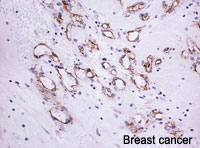Letrozole reduces distant recurrence in hormone-receptor–positive breast cancer
Letrozole significantly reduced the cumulative incidence of breast cancer relapse compared with tamoxifen.
Adjuvant letrozole (Femara, Novartis), an aromatase inhibitor, is more effective than tamoxifen in reducing the risk of recurrent disease in patients with hormone-receptor–positive breast cancer, according to the Breast International Group (BIG) 1-98 Collaborative Group.
“Our initial results suggest that an aromatase inhibitor should be considered in the adjuvant-treatment plan for postmenopausal women with hormone-sensitive breast cancer,” wrote Beat Thürlimann, MD, chair of the BIG 1-98 writing committee, in The New England Journal of Medicine.
Previous research from the Arimidex [anastrozole], Tamoxifen, Alone or in Combination (ATAC) trial and the NCI’s Clinical Trials Group/North American Breast Intergroup’s MA.17 trial (Hem/Onc Today, October 2005) has confirmed the collaborative group’s results.
Superior endpoints
Doug Yee, MD, a member of Hem/Onc Today’s editorial board, agreed. “I think these results are very similar to the ATAC study. When breast cancer endpoints are considered, there is superiority of the aromatase inhibitor over tamoxifen as first-line therapy.
“As with the ATAC study, there is no survival benefit to starting with letrozole. It is important to note that there were more non-breast cancer deaths in the letrozole group. Although these results are also not statistically significant, the beneficial effects of tamoxifen on lipid profiles could account for the difference in these non-breast cancer deaths on letrozole. Careful long-term study will be needed to examine the non-breast cancer–related effects of letrozole, especially in women with a low risk of recurrence,” he said.
|
| |
Source: NCI |
The BIG 1-98 study, a randomized, phase-3, double-blind trial, compared five years of the following adjuvant endocrine therapy regimens: letrozole alone, letrozole followed by tamoxifen, tamoxifen alone and tamoxifen followed by letrozole. Researchers launched the trial because, although tamoxifen reduces the risk of recurrent disease by 47% and the risk of death by 26% among hormone-receptor–positive patients, about half of this patient population will experience relapse.
All patients enrolled in the trial were postmenopausal and had been diagnosed with hormone-receptor–positive breast cancer. In the current analysis, researchers compared the two groups assigned to receive letrozole at the start with the two groups assigned to receive tamoxifen at the start.
Overall, there were 4,003 patients in the letrozole group and 4,007 patients in the tamoxifen group. Baseline characteristics and primary treatment characteristics were comparable between treatment groups. Researchers included all 8,010 patients in the intent-to-treat analysis.
Reducing recurrence
Letrozole improved disease-free survival by 19% (P = .003) and reduced distant recurrence by 27% (P = .001) compared with tamoxifen. The BIG 1-98 Collaborative Group estimated five-year disease-free survival to be similar between treatment arms: 84% for the letrozole group and 81.4% for the tamoxifen group.
“Letrozole significantly reduced the cumulative incidence of breast cancer relapse as compared with tamoxifen,” the researchers wrote. “This difference became evident one year after randomization, and there was an absolute difference of 3.4 percentage points at five years.”
In addition, they found that letrozole was more effective than tamoxifen in improving disease-free survival among patients who received chemotherapy (P = .01), patients who did not undergo radiation therapy (P = .03) and patients with involved axillary lymph nodes (P < .001), according to various subgroup analyses.
Although both letrozole and tamoxifen were generally tolerable, patients in the letrozole arm were more likely to report at least one adverse event, according to the safety analysis. They were also more likely to report fractures than patients in the tamoxifen arm (P < .001).
Tamoxifen was associated with significantly more thromboembolic events, vaginal bleeding and endometrial biopsies (P < .001 for all variables).
Although letrozole was linked to increased cholesterol values, the overall incidence of cardiovascular events was similar between treatment arms: 3.7% for patients receiving letrozole and 4.2% for patients receiving tamoxifen. Patients in the letrozole arm were more likely to experience severe cardiovascular events (P < .001). – by Rebekah Cintolo
For more information:
- The Breast International Group (BIG) 1-98 Collaborative Group. A comparison of letrozole and tamoxifen in postmenopausal women with early breast cancer. N Engl J Med. 2005;353:2747-2757.

